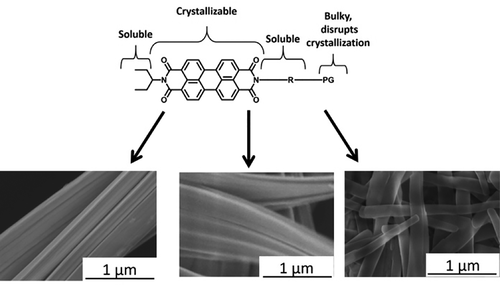当前位置:
X-MOL 学术
›
Chem. Mater.
›
论文详情
Our official English website, www.x-mol.net, welcomes your
feedback! (Note: you will need to create a separate account there.)
Perylene Diimide Bearing Different Trialkyl Silyl Ethers: Impact of Asymmetric Functionalization on Self-Assembly into Nanostructures
Chemistry of Materials ( IF 7.2 ) Pub Date : 2018-04-30 00:00:00 , DOI: 10.1021/acs.chemmater.8b01543 Rachael Matthews 1 , Jordan Swisher 2 , Kristin M. Hutchins 3 , Emily B. Pentzer 1
Chemistry of Materials ( IF 7.2 ) Pub Date : 2018-04-30 00:00:00 , DOI: 10.1021/acs.chemmater.8b01543 Rachael Matthews 1 , Jordan Swisher 2 , Kristin M. Hutchins 3 , Emily B. Pentzer 1
Affiliation

|
For over a decade, a great amount of research effort has focused on controlling the size and shape of organic small molecule crystals, as these parameters impact physical and optoelectronic properties. A thorough understanding of how functionalization impacts assembly as well as guiding principles to control aggregation and self-assembly are vital to producing novel organic nanostructures for electronic applications such as organic photovoltaics (OPVs). Herein, we study the influence of unsymmetrical functionalization of perylene diimide (PDI) on self-assembly. The guiding hypothesis of this work is that the identity of the pendant functionalities will impact the size, aspect ratio, and surface properties of the resulting assemblies. Twelve asymmetrically functionalized PDI molecules are reported, in which the length of the alkyl substituents at the imide position is varied, and include alcohol and silylated alcohol functionalities at the end of the alky chain. Morphologies of these self-assembled structures were characterized by scanning and transmission electronic microscopy; crystallinity was verified by powder X-ray diffraction, and the optoelectronic and thermal properties are also reported. On the basis of the functionality of the PDI molecules, different shaped assemblies are prepared, including high aspect ratio structures with widths ranging from 0.1 to 2.5 μm and lengths 1–800 μm.
中文翻译:

Bearing二酰亚胺带有不同的三烷基甲硅烷基醚:不对称功能化对自组装成纳米结构的影响。
十多年来,大量的研究工作集中在控制有机小分子晶体的大小和形状上,因为这些参数会影响物理和光电性能。彻底了解功能化如何影响组装以及控制聚集和自组装的指导原则对于生产用于电子应用(例如有机光伏(OPV))的新型有机纳米结构至关重要。在这里,我们研究un二酰亚胺(PDI)的不对称功能化对自组装的影响。这项工作的指导假设是,悬垂功能的身份将影响所得装配的尺寸,长宽比和表面特性。据报道有十二个不对称官能化的PDI分子,其中在酰亚胺位置的烷基取代基的长度是变化的,并且在烷基链的末端包括醇和甲硅烷基化的醇官能团。这些自组装结构的形貌通过扫描和透射电子显微镜表征。通过粉末X射线衍射验证了结晶度,并且还报道了光电和热学性质。根据PDI分子的功能,制备了不同形状的组件,包括高纵横比的结构,其宽度范围为0.1到2.5μm,长度为1-800μm。通过粉末X射线衍射验证了结晶度,并且还报道了光电和热学性质。根据PDI分子的功能,制备了不同形状的组件,包括高纵横比的结构,其宽度范围为0.1到2.5μm,长度为1-800μm。通过粉末X射线衍射验证了结晶度,并且还报道了光电和热学性质。根据PDI分子的功能,制备了不同形状的组件,包括高纵横比的结构,其宽度范围为0.1到2.5μm,长度为1-800μm。
更新日期:2018-04-30
中文翻译:

Bearing二酰亚胺带有不同的三烷基甲硅烷基醚:不对称功能化对自组装成纳米结构的影响。
十多年来,大量的研究工作集中在控制有机小分子晶体的大小和形状上,因为这些参数会影响物理和光电性能。彻底了解功能化如何影响组装以及控制聚集和自组装的指导原则对于生产用于电子应用(例如有机光伏(OPV))的新型有机纳米结构至关重要。在这里,我们研究un二酰亚胺(PDI)的不对称功能化对自组装的影响。这项工作的指导假设是,悬垂功能的身份将影响所得装配的尺寸,长宽比和表面特性。据报道有十二个不对称官能化的PDI分子,其中在酰亚胺位置的烷基取代基的长度是变化的,并且在烷基链的末端包括醇和甲硅烷基化的醇官能团。这些自组装结构的形貌通过扫描和透射电子显微镜表征。通过粉末X射线衍射验证了结晶度,并且还报道了光电和热学性质。根据PDI分子的功能,制备了不同形状的组件,包括高纵横比的结构,其宽度范围为0.1到2.5μm,长度为1-800μm。通过粉末X射线衍射验证了结晶度,并且还报道了光电和热学性质。根据PDI分子的功能,制备了不同形状的组件,包括高纵横比的结构,其宽度范围为0.1到2.5μm,长度为1-800μm。通过粉末X射线衍射验证了结晶度,并且还报道了光电和热学性质。根据PDI分子的功能,制备了不同形状的组件,包括高纵横比的结构,其宽度范围为0.1到2.5μm,长度为1-800μm。





















































 京公网安备 11010802027423号
京公网安备 11010802027423号